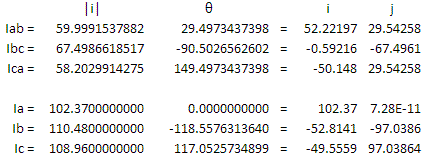For the values you get, probably a combination of compounded rounding errors, in your initial values, my results, and then again in your verification.I agree that your geometric solution would be the way to go. Solving 3 simultaneous equations with 4 unknowns would be too much math for me.
However, I think your method led you astray somewhere. For the values of Iab, Ibc, and Ica that you list above, I come up with:
Ia=101.85<0.51
Ib=110.48<-117.5
Ic=109.50<117.6
Probably just a add/subtract error somewhere.
To demonstrate, your initial values are:
Ia=102.37<0
Ib=110.48<-118.56
Ic=108.96<117.04
If we leave the magnitudes of all three and the angle of Ia as exact, the angle of Ib has to be -118.557631364? while the angle of Ic has to be -242.9474265101? (same as +117.0525734899?) with accuracy carried to 10 decimal places, in order for the three vectors to form a triangle. As stated, the vectors given placed head to tail would form an open polygon. There would be a gap between the last head and the first tail. Correcting the angles for the errors is how I chose to proceed as it was the easiest means. If I chose the more difficult compensation, i.e. proportionally distributing the rounding errors to all five [variable*] values, the verification would have been closer to your initial values.Ib=110.48<-118.56
Ic=108.96<117.04
*Since angles are relative, Ia would remain as 0?

